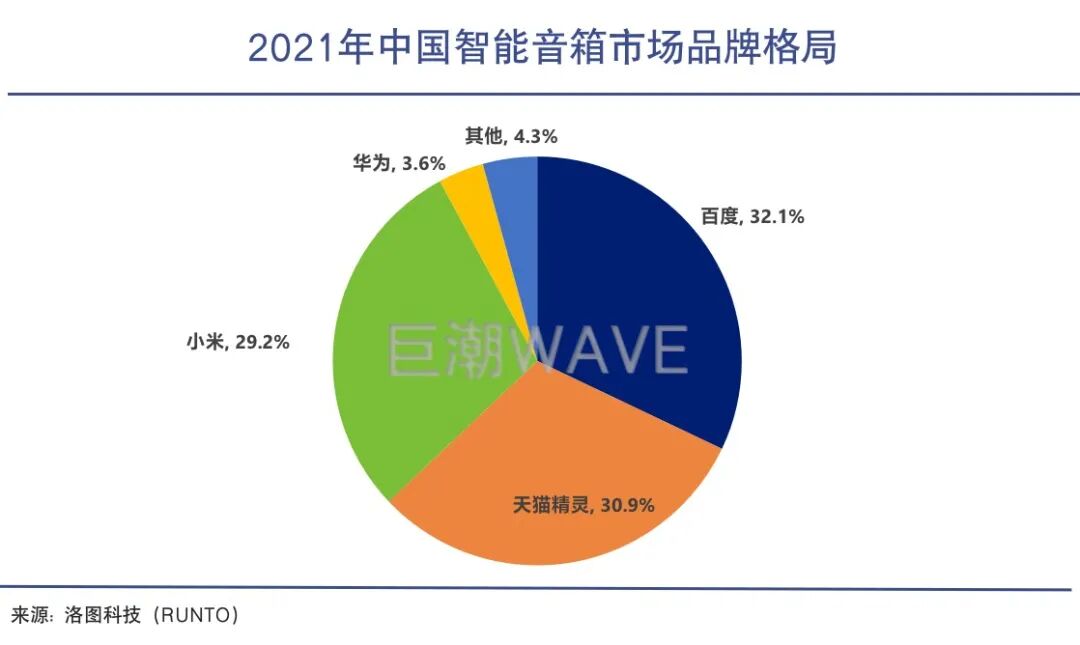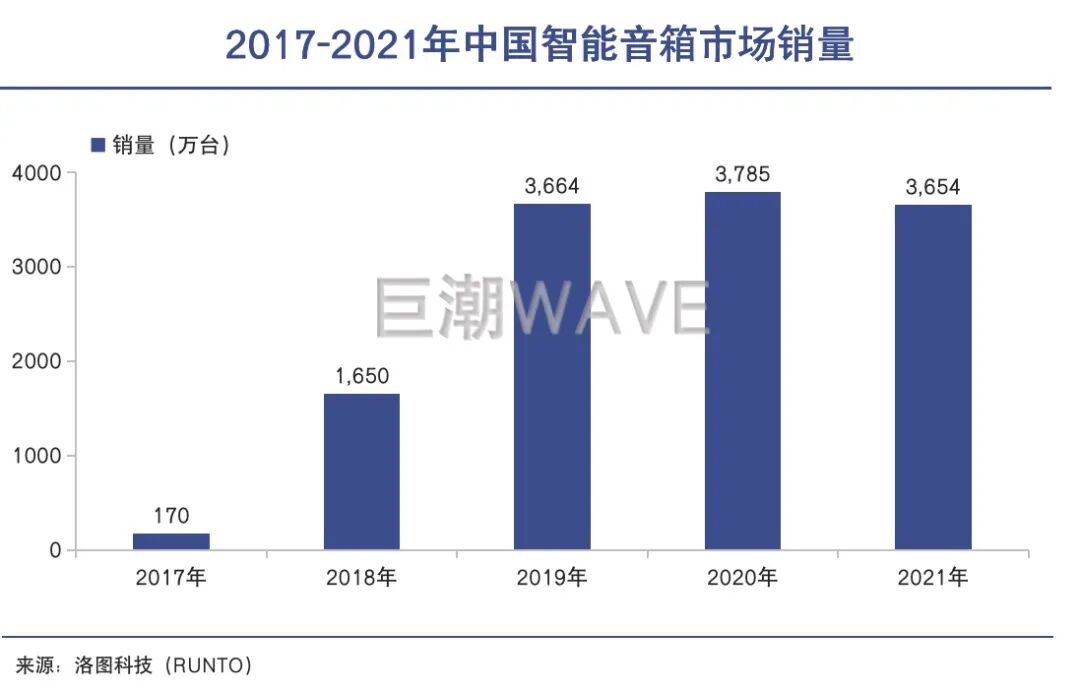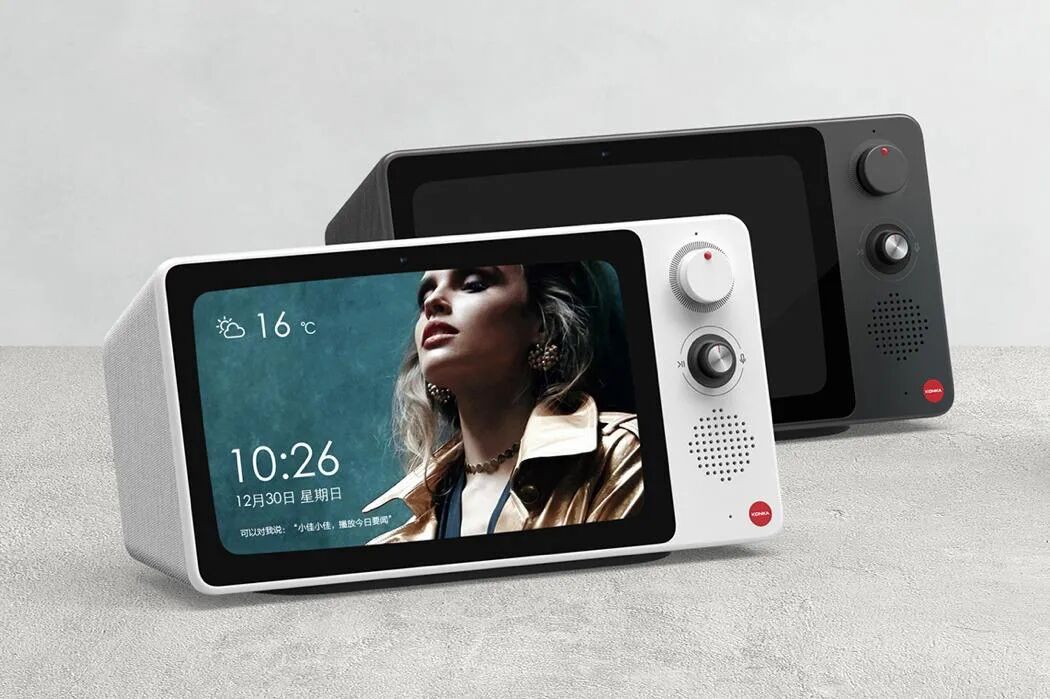

The fundamental reason is that the entry position of smart speakers is facing severe challenges.Author丨Jing YuSource | Giant Tide WAVE (ID: WAVE-BIZ)“Xiao Du, Xiao Du, who do you think is better, Tmall Genie or Xiao Ai?”In addition to playing audio, smart speakers encompass various functions such as voice control of smart home devices, voice information queries, and human-computer dialogue, which have attracted considerable consumer attention.According to data from Lottu Technology, the sales of smart speakers in the domestic market grew from 1.7 million units in 2017 to 36.64 million units in 2019, with sales growth rates of 823% and 126% in 2018 and 2019, respectively. The entire sector experienced explosive growth, and China quickly became the largest smart speaker market in the world.However, the good times did not last long. Since 2020, domestic smart speaker consumption has entered a downturn, with no signs of recovery.This year, against the backdrop of a general cooling in the consumer electronics sector, the chill in the smart speaker market has become even more pronounced. An IDC report stated that in the first half of 2022, the sales of smart speakers in China were 14.83 million units, a year-on-year decrease of 27.1%; sales revenue was 4.2 billion yuan, a year-on-year decrease of 16.2%.Many industry analysts have pointed out that this sector has hit a short-term ceiling.This means a significant “setback” for the main players in the sector. In order to capture user mindshare, Baidu, Xiaomi, and Alibaba have continuously subsidized and “burned money” over the past few years. Although they successfully established a tripartite industry structure, none achieved an overwhelming victory. Now that the sector is generally cooling, the returns from subsidies and investments have become elusive.From a deeper strategic perspective, the main players initially lost money on subsidies not to sell hardware but to focus on the vast Internet of Things market behind smart speakers, viewing them as an important entry point for smart homes.However, as the industry continues to evolve, the value of smart speakers as an entry point for smart homes has not increased; rather, it has gradually diminished, indicating that the fundamental logic for the existence and prosperity of the entire sector has fundamentally changed.– 01 – Subsidized BusinessThe entire sector has been “calm” for two and a half years, and the short-term ceiling is very clear.In 2014, Amazon launched the Echo smart speaker, which captured 75% of the U.S. smart speaker market by 2017, driving the rapid rise of the Chinese smart speaker market.However, in this “battle of hundreds of speakers,” startups are not on the same starting line as giants like BAT and Xiaomi.Cheng Hao, founder of Xunlei, stated in a 2017 interview that the chances of success for startups in the smart speaker field are very slim, and they can easily become cannon fodder. The reason is that the giants attach great importance to this sector and invest heavily to capture the entry point. “In this level of war, startups should stay away.”This judgment has since been proven correct.To occupy the entry point and capture users, Alibaba’s Tmall Genie, Baidu’s Xiaodu, and Xiaomi’s Xiao Ai have all attracted early consumers through money-burning subsidies, making “burning money” the main theme of competition, with leading companies generally incurring losses.Startups naturally find it difficult to bear such intense competition, making the smart speaker sector increasingly a game for the giants. IDC reports show that by 2020, the domestic smart speaker sector had formed a tripartite structure, with Alibaba, Baidu, and Xiaomi accounting for 95.56% of the market share.
Subsidized BusinessThe entire sector has been “calm” for two and a half years, and the short-term ceiling is very clear.In 2014, Amazon launched the Echo smart speaker, which captured 75% of the U.S. smart speaker market by 2017, driving the rapid rise of the Chinese smart speaker market.However, in this “battle of hundreds of speakers,” startups are not on the same starting line as giants like BAT and Xiaomi.Cheng Hao, founder of Xunlei, stated in a 2017 interview that the chances of success for startups in the smart speaker field are very slim, and they can easily become cannon fodder. The reason is that the giants attach great importance to this sector and invest heavily to capture the entry point. “In this level of war, startups should stay away.”This judgment has since been proven correct.To occupy the entry point and capture users, Alibaba’s Tmall Genie, Baidu’s Xiaodu, and Xiaomi’s Xiao Ai have all attracted early consumers through money-burning subsidies, making “burning money” the main theme of competition, with leading companies generally incurring losses.Startups naturally find it difficult to bear such intense competition, making the smart speaker sector increasingly a game for the giants. IDC reports show that by 2020, the domestic smart speaker sector had formed a tripartite structure, with Alibaba, Baidu, and Xiaomi accounting for 95.56% of the market share. Through various promotional methods, the price of smart speakers has been compressed to below 100 yuan, thus penetrating deeper into lower-tier markets. Jing Kun, CEO of Baidu Technology, stated in an interview in August 2019: “Through certain subsidies, we can lower the threshold for this product, reaching from first-tier to sixth-tier cities, allowing more Chinese citizens to access such products.”The “miracle through subsidies” once achieved remarkable results, as mentioned earlier, the domestic smart speaker market rapidly exploded between 2017 and 2019, becoming the largest smart speaker market in the world.However, with the arrival of the pandemic in 2020, the rapid growth of the sector came to a halt. As of now, the entire sector has been “calm” for two and a half years, and the short-term ceiling is very clear.The reasons behind this are multifaceted: speakers are not a necessity; for some domestic consumers, they are optional; the technology for smart speakers to understand and respond to dialogue is not mature or intelligent enough; and consumers have concerns about data security and privacy, among others.But the fundamental reason is that the entry position of smart speakers is facing severe challenges.– 02 –
Through various promotional methods, the price of smart speakers has been compressed to below 100 yuan, thus penetrating deeper into lower-tier markets. Jing Kun, CEO of Baidu Technology, stated in an interview in August 2019: “Through certain subsidies, we can lower the threshold for this product, reaching from first-tier to sixth-tier cities, allowing more Chinese citizens to access such products.”The “miracle through subsidies” once achieved remarkable results, as mentioned earlier, the domestic smart speaker market rapidly exploded between 2017 and 2019, becoming the largest smart speaker market in the world.However, with the arrival of the pandemic in 2020, the rapid growth of the sector came to a halt. As of now, the entire sector has been “calm” for two and a half years, and the short-term ceiling is very clear.The reasons behind this are multifaceted: speakers are not a necessity; for some domestic consumers, they are optional; the technology for smart speakers to understand and respond to dialogue is not mature or intelligent enough; and consumers have concerns about data security and privacy, among others.But the fundamental reason is that the entry position of smart speakers is facing severe challenges.– 02 – Marginalization of Entry PositionThe entry position of smart speakers is no longer secure.Previously, smart speakers were seen as an important entry point for smart homes and a voice interaction platform for the Internet of Things. Therefore, the small smart speaker became a battleground for giants.Tang Mu, general manager of Xiaomi’s smart hardware department, once clearly stated: “Smart speakers are one of the important control entry points in smart home systems, and many manufacturers compete for this entry point, controlling the role of the entry point.”However, as the smart home industry continues to develop and products become increasingly diverse, the entry position of smart speakers has become less secure.The reason they were seen as the entry point for smart homes was mainly due to their low cost, convenient wake-up from standby, and low learning cost for language interaction.However, smart speakers also have some shortcomings, such as weak voice interaction capabilities and poor cross-scenario and cross-task dialogue abilities, making it difficult for consumers to control appliances smoothly through dialogue.Generally speaking, the effectiveness of voice operations is far below that of touch screens.It can be seen that more and more manufacturers are using smartphones, tablets, TVs, and smart central control screens as interactive entry points for smart homes: for example, Apple, Xiaomi, and OPPO are promoting smartphones as the central hub for smart homes; while Huawei, Xiaomi, Haier, and Orvibo have successively launched smart central control screens. These interactive devices generally adopt a “touch + voice” method for control, providing a better experience than the single voice control method of smart speakers.In any case, smart speakers are no longer the only entry point for smart homes; multiple entry points are gradually becoming a trend, representing a form of “decentralization.”
Marginalization of Entry PositionThe entry position of smart speakers is no longer secure.Previously, smart speakers were seen as an important entry point for smart homes and a voice interaction platform for the Internet of Things. Therefore, the small smart speaker became a battleground for giants.Tang Mu, general manager of Xiaomi’s smart hardware department, once clearly stated: “Smart speakers are one of the important control entry points in smart home systems, and many manufacturers compete for this entry point, controlling the role of the entry point.”However, as the smart home industry continues to develop and products become increasingly diverse, the entry position of smart speakers has become less secure.The reason they were seen as the entry point for smart homes was mainly due to their low cost, convenient wake-up from standby, and low learning cost for language interaction.However, smart speakers also have some shortcomings, such as weak voice interaction capabilities and poor cross-scenario and cross-task dialogue abilities, making it difficult for consumers to control appliances smoothly through dialogue.Generally speaking, the effectiveness of voice operations is far below that of touch screens.It can be seen that more and more manufacturers are using smartphones, tablets, TVs, and smart central control screens as interactive entry points for smart homes: for example, Apple, Xiaomi, and OPPO are promoting smartphones as the central hub for smart homes; while Huawei, Xiaomi, Haier, and Orvibo have successively launched smart central control screens. These interactive devices generally adopt a “touch + voice” method for control, providing a better experience than the single voice control method of smart speakers.In any case, smart speakers are no longer the only entry point for smart homes; multiple entry points are gradually becoming a trend, representing a form of “decentralization.” On the other hand, even if the giants firmly grasp the smart speaker entry point for smart homes, it is not easy for them to make money from the smart home market.Due to the lack of unified standards, various smart home players in China are fighting their own battles, making it difficult for smart hardware products from different suppliers and ecosystems to work together, leading to complex interest games. In the IoT ecosystem formed by “end, network, and cloud,” smart speakers are just one endpoint of this ecosystem.The situation in foreign markets is similar. Major players seem to no longer bet on smart speakers as important entry points for smart homes, and are streamlining their product lines. For instance, Google discontinued the once best-selling smart speaker, Home Mini, last December, and Apple announced the discontinuation of HomePod in March last year.– 03 –
On the other hand, even if the giants firmly grasp the smart speaker entry point for smart homes, it is not easy for them to make money from the smart home market.Due to the lack of unified standards, various smart home players in China are fighting their own battles, making it difficult for smart hardware products from different suppliers and ecosystems to work together, leading to complex interest games. In the IoT ecosystem formed by “end, network, and cloud,” smart speakers are just one endpoint of this ecosystem.The situation in foreign markets is similar. Major players seem to no longer bet on smart speakers as important entry points for smart homes, and are streamlining their product lines. For instance, Google discontinued the once best-selling smart speaker, Home Mini, last December, and Apple announced the discontinuation of HomePod in March last year.– 03 – Hard to Become “Essential”To become an essential electronic device, one must have the opportunity to become a potential entry point for smart homes.For a growth-oriented sector, the stagnation or even shrinkage of the entire sector is not particularly frightening for the giants; this is a situation that many growth-oriented sectors encounter, characterized by twists and turns.The more serious issue is the collapse of the business model. Just like the marginalization of the entry position of smart speakers, it means that the entire sector is wearing a tightening spell, greatly reducing growth space.In this context, the strategies of smart speaker players have also undergone significant changes.On one hand, although smart speakers are no longer the sole entry point for smart homes, they still remain one of the entry points. The three domestic giants still value the position of smart speakers as entry points for smart homes, and have launched smart speakers with screens. Amazon also launched the Echo Show 15 smart display in February this year.Smart speakers with screens use a “voice + touch” method to control the entire smart home, compensating for the shortcomings of the smart speaker operation experience and better fulfilling the role of smart home entry points.On the other hand, players are no longer occupying entry points with low prices, and subsidies for speaker products have decreased, while they are trying to better meet consumer demands for speakers, fully utilizing the functions of speakers beyond being smart home entry points—better sound quality, richer built-in software applications, audio and video educational resources, etc.The reasons behind this are not difficult to understand: to compete with smartphones, tablets, and smart central control screens for the position of smart home entry points, smart speakers must evolve to be more user-friendly, more valuable, and more powerful, to have a chance to become a potential entry point for smart homes.
Hard to Become “Essential”To become an essential electronic device, one must have the opportunity to become a potential entry point for smart homes.For a growth-oriented sector, the stagnation or even shrinkage of the entire sector is not particularly frightening for the giants; this is a situation that many growth-oriented sectors encounter, characterized by twists and turns.The more serious issue is the collapse of the business model. Just like the marginalization of the entry position of smart speakers, it means that the entire sector is wearing a tightening spell, greatly reducing growth space.In this context, the strategies of smart speaker players have also undergone significant changes.On one hand, although smart speakers are no longer the sole entry point for smart homes, they still remain one of the entry points. The three domestic giants still value the position of smart speakers as entry points for smart homes, and have launched smart speakers with screens. Amazon also launched the Echo Show 15 smart display in February this year.Smart speakers with screens use a “voice + touch” method to control the entire smart home, compensating for the shortcomings of the smart speaker operation experience and better fulfilling the role of smart home entry points.On the other hand, players are no longer occupying entry points with low prices, and subsidies for speaker products have decreased, while they are trying to better meet consumer demands for speakers, fully utilizing the functions of speakers beyond being smart home entry points—better sound quality, richer built-in software applications, audio and video educational resources, etc.The reasons behind this are not difficult to understand: to compete with smartphones, tablets, and smart central control screens for the position of smart home entry points, smart speakers must evolve to be more user-friendly, more valuable, and more powerful, to have a chance to become a potential entry point for smart homes. △More and more smart speakers come with screensTherefore, major players have recently been innovating their products in various ways. For example, Baidu has just launched the Tiantian smart rotating screen, which can flip for vertical video viewing and has added karaoke functions to stimulate consumer demand; Xiaomi has launched a high-end product, Xiaomi Sound, tuned by Harman Kardon, which clearly distinguishes itself from previous low-cost smart speaker products.The definition of smart speaker products is thus becoming increasingly blurred. To better meet the requirements of smart home entry points, screen-equipped speakers are largely replacing traditional non-screen speakers, and their product definitions are becoming increasingly ambiguous. Their ultimate form is as a voice assistant, compatible with a variety of rich hardware.Taking Baidu Technology as an example, its overall business structure is “1+X+Y,” where 1 is the voice natural interaction system, X refers to the interactive hardware empowered by 1, and Y represents the smart home and IoT ecosystem.Although players have made efforts to explore innovations in production capacity and application scenarios, from the industry’s performance in the first half of the year, these innovations have not managed to impress consumers and bring the entire industry back to a growth trend.The North American market is also experiencing similar trends. A report from Omdia predicts that the annual compound growth rate of smart speaker shipments in North America from 2021 to 2026 is expected to be only 1.3%, with Amazon’s smart speaker’s annual compound growth rate expected to fall into negative territory.– 04 –
△More and more smart speakers come with screensTherefore, major players have recently been innovating their products in various ways. For example, Baidu has just launched the Tiantian smart rotating screen, which can flip for vertical video viewing and has added karaoke functions to stimulate consumer demand; Xiaomi has launched a high-end product, Xiaomi Sound, tuned by Harman Kardon, which clearly distinguishes itself from previous low-cost smart speaker products.The definition of smart speaker products is thus becoming increasingly blurred. To better meet the requirements of smart home entry points, screen-equipped speakers are largely replacing traditional non-screen speakers, and their product definitions are becoming increasingly ambiguous. Their ultimate form is as a voice assistant, compatible with a variety of rich hardware.Taking Baidu Technology as an example, its overall business structure is “1+X+Y,” where 1 is the voice natural interaction system, X refers to the interactive hardware empowered by 1, and Y represents the smart home and IoT ecosystem.Although players have made efforts to explore innovations in production capacity and application scenarios, from the industry’s performance in the first half of the year, these innovations have not managed to impress consumers and bring the entire industry back to a growth trend.The North American market is also experiencing similar trends. A report from Omdia predicts that the annual compound growth rate of smart speaker shipments in North America from 2021 to 2026 is expected to be only 1.3%, with Amazon’s smart speaker’s annual compound growth rate expected to fall into negative territory.– 04 – Final ThoughtsThe product innovation and scenario exploration of smart speaker players are related to the short-term prosperity of the entire sector.However, in the long run, the improvement of voice interaction technology is the key to determining the future of the smart speaker industry.The ultimate vision of smart voice interaction players is to achieve barrier-free free dialogue like a real person and to “control everything.” At that time, smart voice interaction systems, whether applied in smart homes, robots, or new energy vehicles, will release tremendous value.Although smart speaker players are already working hard to expand their user base to train their voice interaction systems, the voice interaction capabilities of smart speakers still often fall short. This can be seen as a technical dilemma and limitation that cannot be compensated for through the market and subsidies.This article represents the author’s independent viewpoint and does not reflect the position of Pencil Road. The original title is “Smart Speakers Struggle to Avoid the Fate of Dust Accumulation.”
Final ThoughtsThe product innovation and scenario exploration of smart speaker players are related to the short-term prosperity of the entire sector.However, in the long run, the improvement of voice interaction technology is the key to determining the future of the smart speaker industry.The ultimate vision of smart voice interaction players is to achieve barrier-free free dialogue like a real person and to “control everything.” At that time, smart voice interaction systems, whether applied in smart homes, robots, or new energy vehicles, will release tremendous value.Although smart speaker players are already working hard to expand their user base to train their voice interaction systems, the voice interaction capabilities of smart speakers still often fall short. This can be seen as a technical dilemma and limitation that cannot be compensated for through the market and subsidies.This article represents the author’s independent viewpoint and does not reflect the position of Pencil Road. The original title is “Smart Speakers Struggle to Avoid the Fate of Dust Accumulation.”


Welcome to Contact
For reporting, please contact: w_tsou
For business cooperation, please contact: renguozhou2019
For inquiries about brand innovation and marketing services, please contact:tongtong0211
For joining the entrepreneurial community, please contact:Pencil-news
For market cooperation, please contact: Pencil-news

Recommended Reading


 Follow Us
Follow Us
 If you like it, don’t forget to share, like, and check it out!
If you like it, don’t forget to share, like, and check it out!